A backyard greenhouse is a fantastic addition for anyone looking to grow plants year-round, no matter the weather outside. These handy structures provide an ideal environment for nurturing everything from vegetables to flowers, giving you control over temperature, humidity, and light. Whether you’re a seasoned gardener or just starting out, a greenhouse can make your gardening efforts more rewarding and enjoyable.
Choosing the Right Location for Your Greenhouse
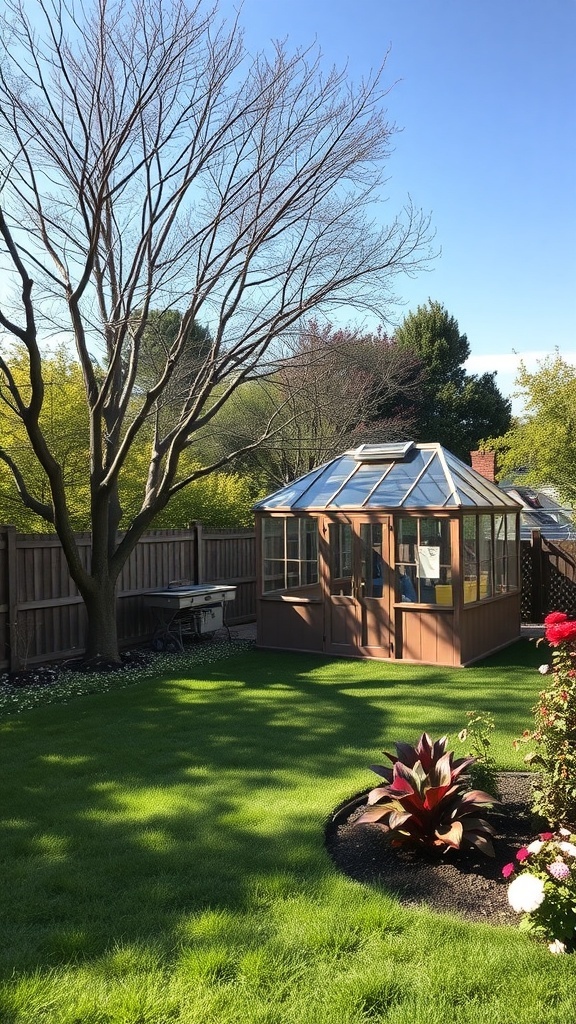
Finding the perfect spot for your greenhouse is key to its success. The image shows a charming greenhouse nestled in a vibrant backyard. It’s surrounded by lush green grass and colorful flowers, creating a lovely atmosphere.
When choosing a location, sunlight is a top priority. Your greenhouse should receive plenty of natural light throughout the day. The clear glass panels of the greenhouse in the image suggest it’s designed to maximize sunlight exposure.
Next, consider wind protection. The tall tree nearby offers some shelter, which can help reduce wind damage. A location with natural barriers can be beneficial for maintaining a stable environment inside your greenhouse.
Accessibility is another factor. You want to easily reach your greenhouse for watering and harvesting. The path leading to the greenhouse in the picture looks inviting and practical.
Lastly, think about drainage. A well-drained area prevents water from pooling around your greenhouse. The grassy area shown seems to have good drainage, which is essential for healthy plants.
Essential Materials for Building a Greenhouse
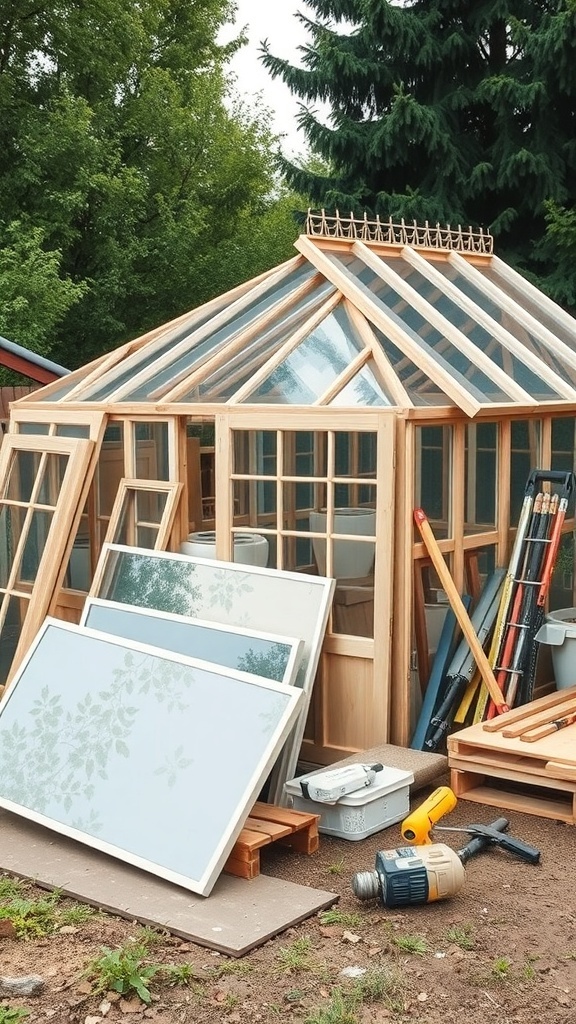
Building a greenhouse can be a fun project that adds charm to your backyard. In the image, you can see a partially constructed greenhouse, showcasing a blend of wood and glass. This structure is designed to let in plenty of sunlight while providing shelter for your plants.
First up, you’ll need a sturdy frame. Wood is a popular choice, as seen in the image. It’s durable and gives a natural look. Make sure to choose treated wood to resist moisture and pests.
Next, glass panels are essential. They allow sunlight to enter while protecting plants from harsh weather. The image shows several glass panels ready to be installed. You can also consider polycarbonate panels for better insulation.
Don’t forget about the foundation. A solid base is crucial for stability. You can use concrete blocks or a gravel foundation to keep everything level and secure.
Lastly, gather tools like a drill, saw, and measuring tape. The image features some tools that will help you assemble your greenhouse efficiently. With the right materials and tools, you’ll be well on your way to creating a beautiful space for your plants!
Watering Systems for Efficient Plant Care
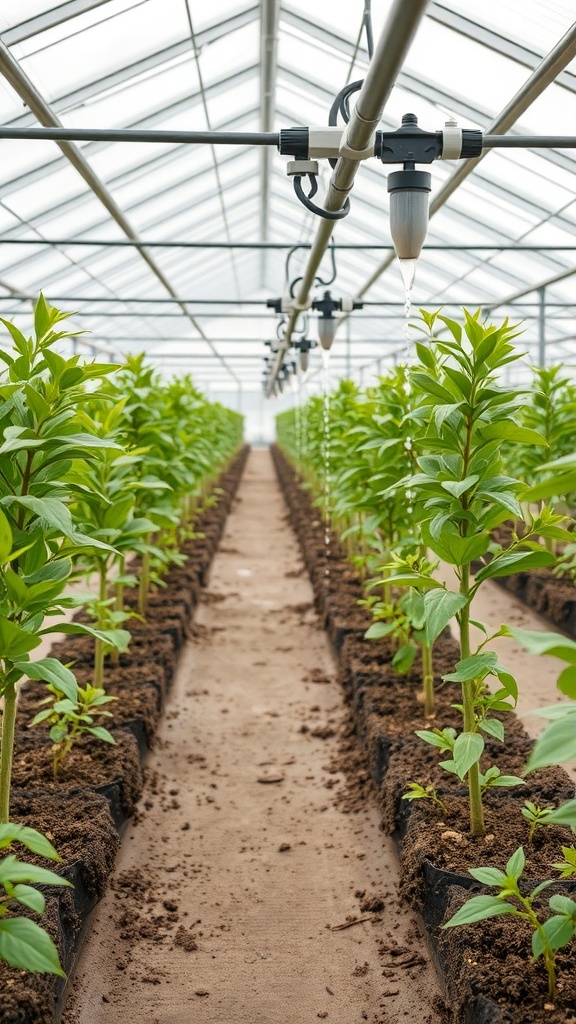
In a backyard greenhouse, having an efficient watering system is key to keeping your plants healthy and thriving. The image shows a well-organized setup with rows of vibrant plants, each receiving the right amount of water through a drip irrigation system. This method delivers water directly to the roots, minimizing waste and ensuring that plants get what they need.
Drip irrigation is not just efficient; it also saves time. Instead of manually watering each plant, you can set up a timer to automate the process. This means you can spend more time enjoying your greenhouse and less time worrying about watering schedules.
Another benefit of this system is that it reduces the risk of overwatering. By controlling the flow of water, you can prevent issues like root rot, which can be a common problem in greenhouses. The image highlights how the water drips gently from the pipes, soaking into the soil without flooding the plants.
For those looking to set up a similar system, consider using a combination of hoses, emitters, and a timer. This setup can be tailored to fit the specific needs of your plants, making it a versatile choice for any greenhouse enthusiast.
Temperature Control Techniques for Optimal Growth
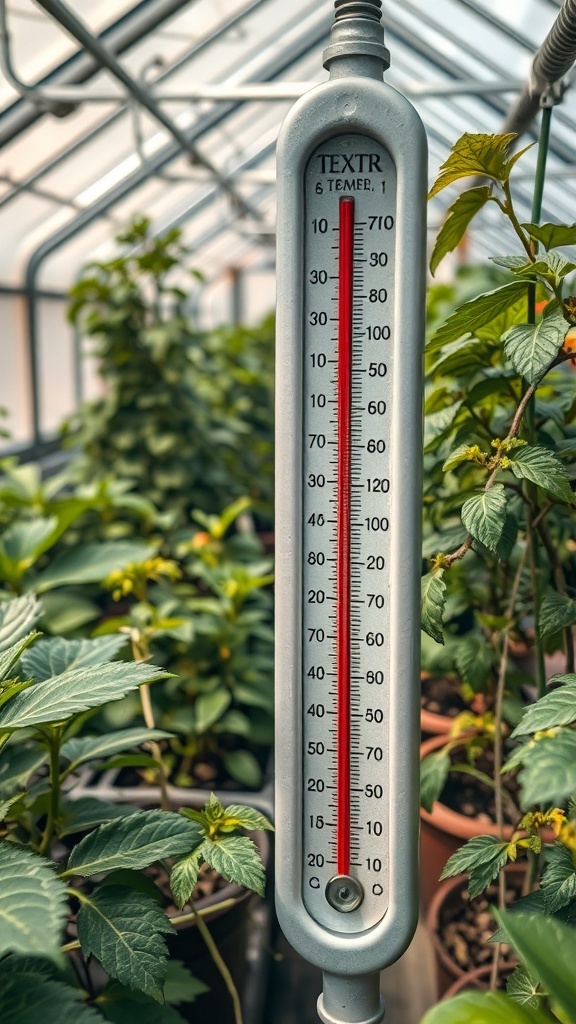
In a backyard greenhouse, temperature control is key for healthy plant growth. The image shows a thermometer, which is essential for monitoring the climate inside. Keeping an eye on the temperature helps ensure that plants thrive.
One effective technique is using a thermostat. This device can automatically adjust heating or cooling systems to maintain a steady temperature. It’s a simple way to create a stable environment for your plants.
Another method is ventilation. Opening windows or using fans can help regulate heat, especially on sunny days. Proper airflow prevents overheating and keeps humidity levels in check.
Shade cloths are also useful. They can block excessive sunlight, reducing heat buildup. This is particularly helpful during the hottest months when plants are most vulnerable.
Lastly, consider thermal mass. Adding water barrels or stones can absorb heat during the day and release it at night. This natural method helps maintain a more consistent temperature.
Pest Management Strategies in a Greenhouse
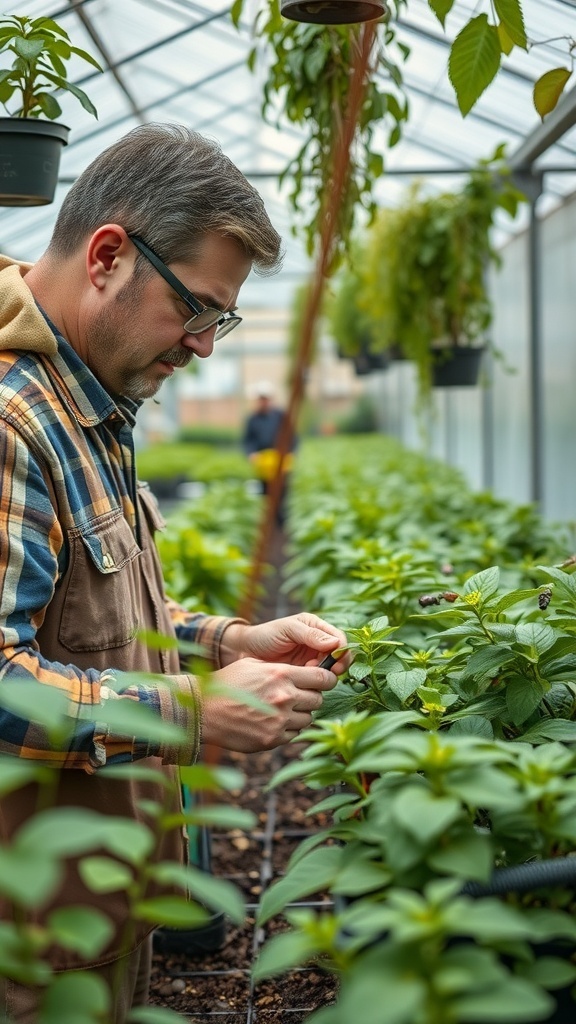
Managing pests in a greenhouse is key to keeping your plants healthy and thriving. In the image, we see a person standing among lush greenery, likely checking on the plants. This setting highlights the importance of close monitoring in pest management.
Regular inspections are a great first step. Look for any signs of pests or diseases. Early detection can save your plants from serious damage. You can also use sticky traps to catch flying insects. These traps are simple and effective.
Another strategy is to introduce beneficial insects. Ladybugs and lacewings can help control aphid populations naturally. This method is eco-friendly and supports a balanced ecosystem in your greenhouse.
Using organic pesticides can also be a part of your strategy. Products made from natural ingredients can be less harmful to beneficial insects and the environment. Always follow the instructions to ensure safety.
Lastly, maintaining good hygiene in your greenhouse is essential. Remove any dead plants and debris that can harbor pests. Keeping your space clean helps prevent infestations and promotes healthy growth.
Designing Your Greenhouse Layout
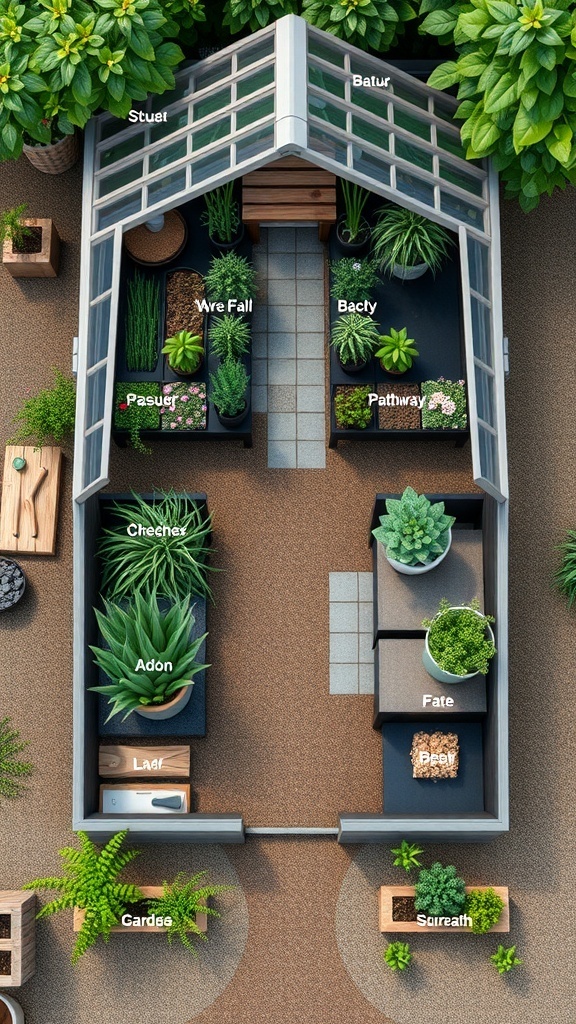
Creating a greenhouse layout is an exciting step in your gardening journey. The image shows a well-organized greenhouse with various plant sections and pathways. Each area is labeled, making it easy to visualize how to arrange your plants.
The layout features a central pathway that allows easy access to all sections. This design helps you move around without stepping on plants. On the left, you’ll find labeled areas like ‘Adon’ and ‘Cheener,’ which likely hold different types of plants. This variety can help you maximize your growing potential.
Consider the sunlight each section receives. Plants like succulents might thrive in brighter spots, while others may prefer shadier areas. The ‘Wire Fall’ section appears to have a unique arrangement, possibly for hanging plants or vines. This adds a creative touch to your greenhouse.
Don’t forget about the seating area, labeled ‘Stuart.’ Having a spot to relax can make your greenhouse a pleasant retreat. You can enjoy the fruits of your labor while planning your next gardening project. The overall layout is both functional and inviting, making it a great model for your own greenhouse.
Seasonal Care Tips for Greenhouse Plants
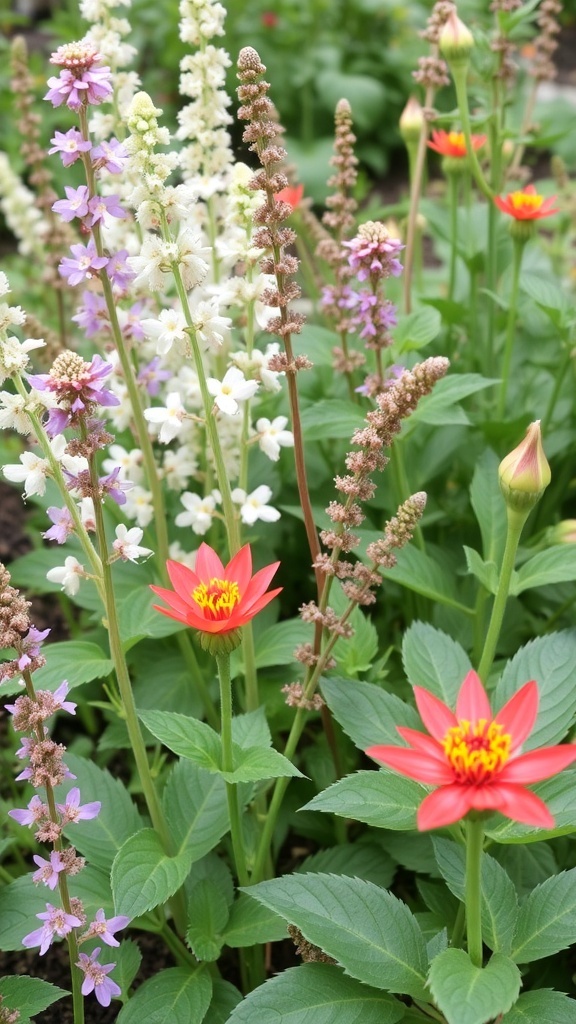
A backyard greenhouse can be a wonderful space for growing plants year-round. In this image, we see a well-organized greenhouse with various potted plants and a calendar hanging on the wall. This calendar is a handy tool for keeping track of seasonal care tasks for the plants.
Seasonal changes can affect how you care for your greenhouse plants. In spring, it’s time to start planting seeds and young plants. The calendar likely includes reminders for when to water, fertilize, and check for pests. Keeping a schedule helps ensure your plants thrive.
During summer, plants may need more water and shade. The calendar can guide you on when to adjust watering schedules or provide extra care. As fall approaches, it’s essential to prepare for cooler temperatures. The calendar might suggest bringing in tender plants or adjusting ventilation.
Winter care is crucial too. Some plants may need special attention, like reduced watering or additional warmth. The calendar serves as a reminder for these important tasks, helping you keep your plants healthy during the colder months.
Choosing the Right Plants for Your Greenhouse

When setting up your backyard greenhouse, picking the right plants is key. The image shows a vibrant greenhouse filled with various plants, showcasing the potential of what you can grow. From hanging plants to lush greens, the options are endless.
Start by considering your climate. Some plants thrive in warmer conditions, while others prefer cooler temperatures. If your greenhouse is well-insulated, you might opt for tropical plants like ferns and orchids. On the other hand, if it’s cooler, leafy greens like lettuce and spinach can flourish.
Next, think about the space you have. The image displays a mix of potted plants and hanging varieties. Utilizing vertical space can help you grow more. Herbs are a great choice for smaller areas, as they can be grown in pots or even on shelves.
Don’t forget about the light! Some plants need full sun, while others do well in partial shade. Observing how light enters your greenhouse will help you decide where to place your plants. This way, you can create a thriving environment for each type.
Lastly, consider your personal preferences. If you love cooking, growing herbs and vegetables can be rewarding. If you enjoy flowers, vibrant blooms can add beauty and color. The image captures a delightful mix, reminding us that the right plants can transform your greenhouse into a personal paradise.
Ventilation Solutions for a Healthy Environment
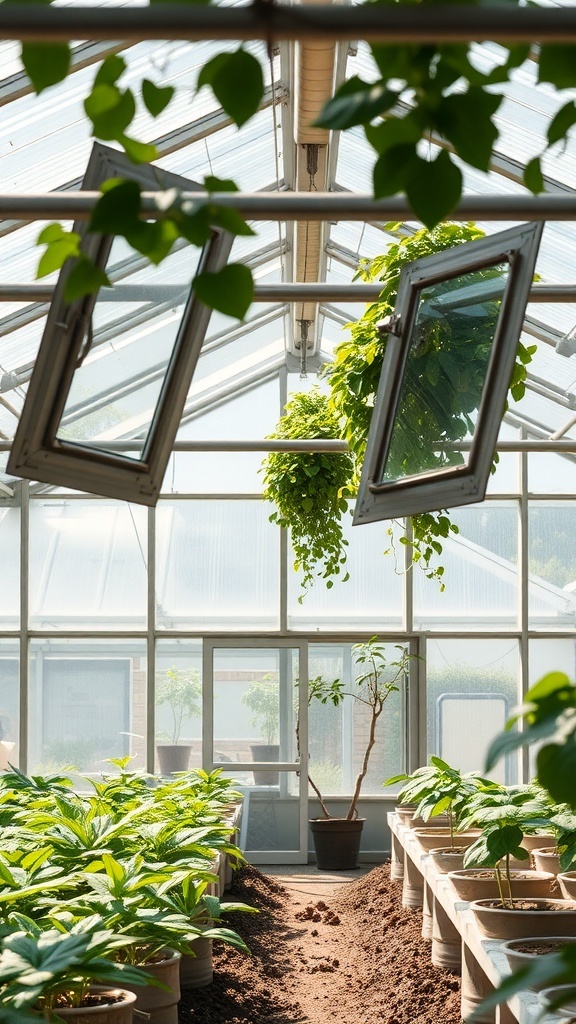
In a backyard greenhouse, proper ventilation is key to keeping plants healthy. The image shows a bright space filled with lush greenery and open windows, allowing fresh air to circulate. This setup helps maintain the right temperature and humidity levels, which are crucial for plant growth.
Open windows, like those seen in the image, can be a simple yet effective way to promote airflow. They allow hot air to escape while inviting cooler air in. This natural ventilation is often preferred, especially on warm days.
Another option is using fans to enhance airflow. Fans can help distribute air evenly throughout the greenhouse, preventing hot spots. Combining natural ventilation with fans can create a balanced environment for your plants.
It’s also important to monitor humidity levels. Too much moisture can lead to mold and mildew, while too little can stress plants. Using hygrometers can help you keep track of these levels, ensuring your plants thrive.
Overall, a well-ventilated greenhouse can make all the difference. By incorporating these solutions, you can create a healthy environment that supports vibrant plant life.
Lighting Options to Enhance Plant Growth

In a backyard greenhouse, lighting plays a key role in plant growth. The image shows a well-lit space filled with vibrant plants, thriving under various light sources. The purple hue from the LED lights indicates a spectrum that promotes healthy growth.
Using LED grow lights is a popular choice among gardeners. They are energy-efficient and can be adjusted to provide the right light intensity for different plants. This flexibility helps in creating an ideal environment for seedlings and mature plants alike.
Natural sunlight is also important. Positioning your greenhouse to maximize sunlight exposure can complement artificial lighting. Combining both methods ensures that plants receive the full spectrum of light they need.
Timers can be a helpful addition. They allow you to set specific light cycles, mimicking natural day and night patterns. This consistency can boost plant health and productivity.
Sustainable Practices for Eco-Friendly Gardening
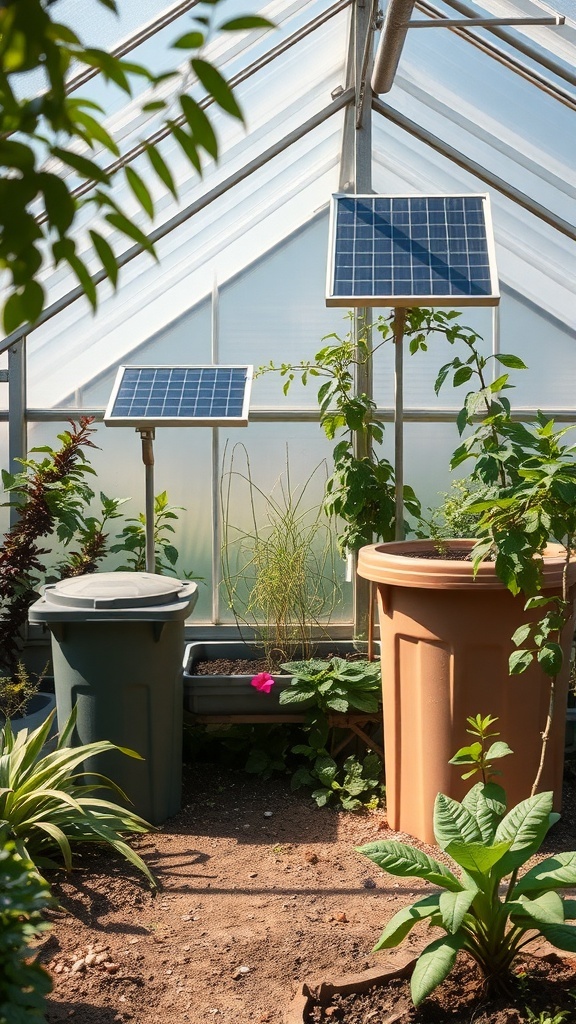
In the image, we see a bright and inviting backyard greenhouse filled with greenery. The structure features solar panels, which are a fantastic way to harness renewable energy for gardening. This setup not only supports plant growth but also reduces reliance on traditional energy sources.
The presence of various plants, along with compost bins, highlights the importance of recycling organic waste. Composting enriches the soil and promotes healthy plant growth, making it a key practice for eco-friendly gardening.
Using a greenhouse allows for year-round gardening, offering a controlled environment that can protect plants from harsh weather. This means you can grow your favorite vegetables and herbs while minimizing the use of pesticides and fertilizers.
Incorporating sustainable practices like these can lead to a thriving garden that benefits both you and the environment. So, whether you’re a seasoned gardener or just starting out, consider how you can make your gardening practices more sustainable.
Harvesting and Maintaining Your Greenhouse Garden
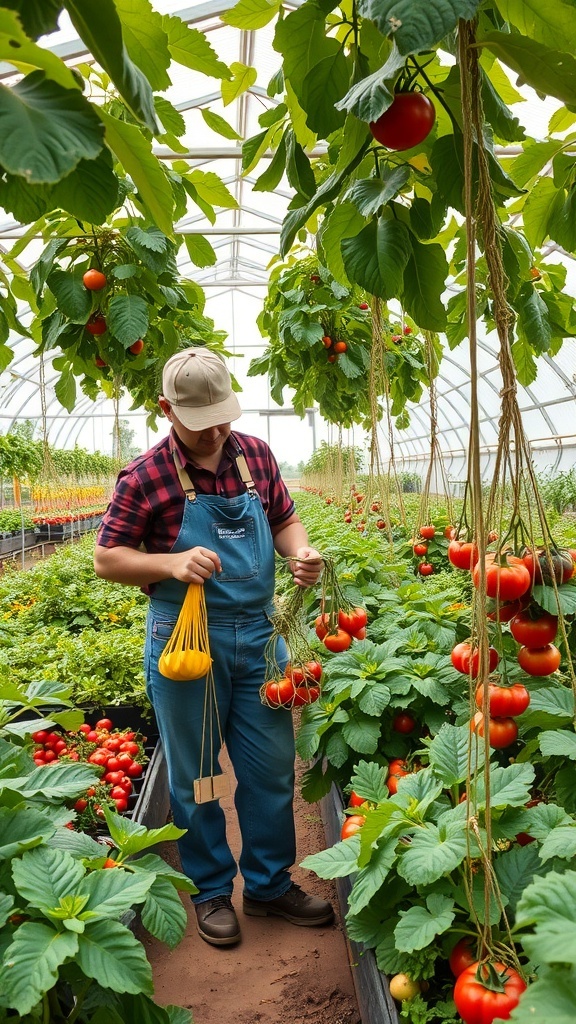
Harvesting from your greenhouse is a rewarding experience. In the image, we see a person carefully picking ripe tomatoes, showcasing the fruits of their labor. These vibrant red tomatoes hang from lush green plants, indicating a healthy growing environment.
To maintain your greenhouse garden, regular checks on plant health are key. Ensure your plants are getting enough water and nutrients. Pruning is also important; it helps promote growth and prevents diseases.
Using the right tools makes harvesting easier. A simple basket or bag can help gather your produce without damaging the plants. After harvesting, it’s good to clean your tools to prevent the spread of pests.
Lastly, enjoy the process! Gardening can be a peaceful escape, and sharing your harvest with friends and family makes it even more special.
Greenhouse Accessories to Boost Productivity
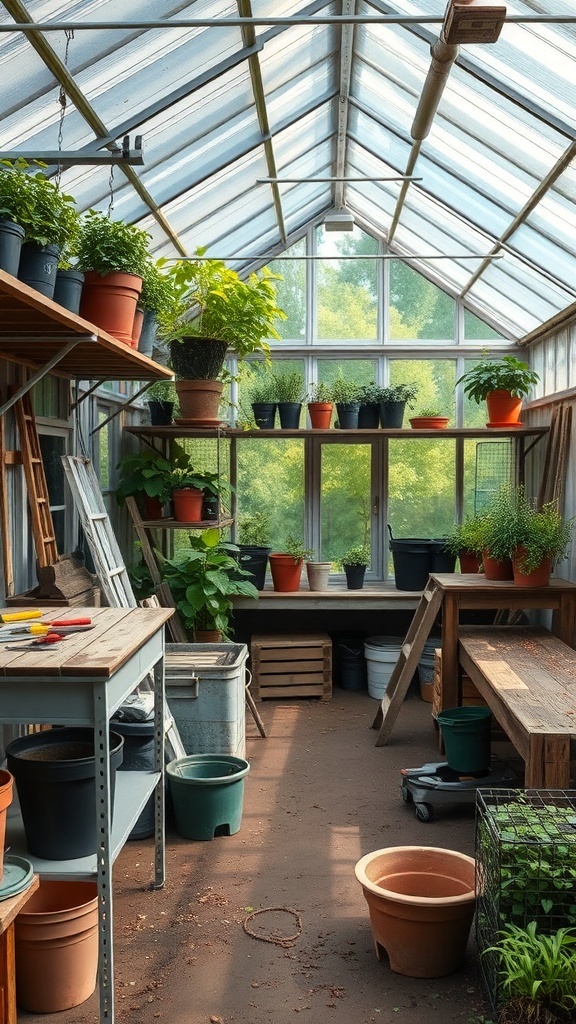
Having a backyard greenhouse is a fantastic way to grow your plants year-round. To make the most of your space, consider adding some essential accessories that can really boost productivity.
In the image, you can see a well-organized greenhouse filled with various plants in pots. The shelves are lined with greenery, creating a vibrant atmosphere. This setup not only looks inviting but also makes it easier to care for your plants.
One useful accessory is a potting bench. It provides a dedicated space for planting and repotting, keeping your work area tidy. You can also include storage bins for tools and supplies, making everything easily accessible.
Another great addition is a watering system. Whether it’s a simple watering can or a more advanced drip irrigation setup, having a reliable way to water your plants can save time and ensure they get the moisture they need.
Don’t forget about grow lights, especially if your greenhouse doesn’t get enough natural sunlight. These lights can help your plants thrive, even during the darker months.
Lastly, consider adding a thermometer and hygrometer to monitor temperature and humidity levels. Keeping an eye on these factors can help you create the perfect environment for your plants.
